Unit 2: Economic Systems - PowerPoint PPT Presentation
Title:
Unit 2: Economic Systems
Description:
Unit 2: Economic Systems IES Llu s de Requesens (Molins de Rei) Batxillerat Social Economics (CLIL) Innovaci en Lleng es Estrangeres Jordi Franch Parella – PowerPoint PPT presentation
Number of Views:62
Avg rating:3.0/5.0
Title: Unit 2: Economic Systems
1
Unit 2 Economic Systems
- IES Lluís de Requesens (Molins de Rei)?
- Batxillerat Social
- Economics (CLIL) Innovació en Llengües
Estrangeres - Jordi Franch Parella
2
Objectives
- In this unit, the students will learn the main
characteristics of the three different economic
systems - - Free market economy
- - Mixed economy
- - Planned economy
- They will also learn the key points in the
thought of their intellectual fathers.
3
Adam Smith
(Click here)?
- Adam Smith (1723-1790) is considered the
father of modern economic theory. - He is the author of The Wealth of Nations
(1776). - He truly understood the importance of saving
and established the law of supply and demand. But
he was wrong with the objective theory of the
labour-value, that influenced Marx.
4
Richard Cantillon
(Click here)?
- Recent research has discovered that Richard
Cantillon (1680-1734) can be considered the
father of the free market economy with his work
Ensayo sobre la naturaleza del comercio. He was
the first to understand the effects of the
increment in the quantity of money (inflation)
and the process involving changes in the relative
prices and distributing the income unfairly.
5
Karl Marx
(Click here)?
- Karl Marx (1818-1883) is the author of Das
Kapital (1867) and is the father of planned
economy or communism. He claimed that the labour
was the unique source of value and that
capitalists took it away from workers. He was
also wrong in believing that a false divide is
between labour and capitalist classes. In a
planned economy there is no private property and
all belongs to the state, that decides for you
what to study, where to work and whether you have
a right to life.
6
John Maynard Keynes
(Click here)?
- Keynes (1883-1946) was the author of the General
Theory (1936) and the father of mixed economy.
He mistrust free market for reaching full
employment and supported the role of government
to interfere society both fiscal and monetary.
The former involves public spending, deficits and
huge debts and the latter the creation of money
out of thin air, to fix interest rates
artificially low and the expansion of credit.
7
Market Economies
- Resources are owned and controlled by individuals
- Economic decisions are made by individuals
competing to earn profits - Individual freedom is considered very important
- Economic decisions are made by the basic
principals of supply and demand - Profit is the motive that guides firms in their
attempts to serve the consumers
8
Market Economies
- Also called capitalist economies
- There are many economic freedoms
- There is competition among businesses
- Competition determines price which increase the
quality of the product
9
Command Economies
- The government or other central authority makes
decisions and determines how resources will be
used - There is no private property, nor markets, nor
supply and demand, nor prices - There is little individual freedom
- There is no competition
- Businesses are not run to create a profit
10
Command Economies
- Consumers have few choices in the market place
- Factories are concerned with quotas
- Shortages are common because of poorly run
factories and farms - The government dictates the job in which you work
11
Command Economies
- The government sets the prices of goods and
services - Examples of command economies Cuba, North Korea
and the Peoples Republic of China
12
Mixed Economies
- Private property is allowed, but the government
takes an active role in society - It does mean that the ratio public spending / GDP
is high (40 USA, more than 40 Spain, 50
Germany, 55 France, 60 Sweden ...)? - It involves that the government commits itself to
provide public education, public health, public
pensions ... (Welfare state)? - In monetary terms, the Central Bank fixes
interest rates, inflates monetary supply and
takes control of commercial banks in
orchestrating credit expansion
13
Review
- Three Types of Economies
- Market Economies
- Planned Economies
- Mixed Economies































